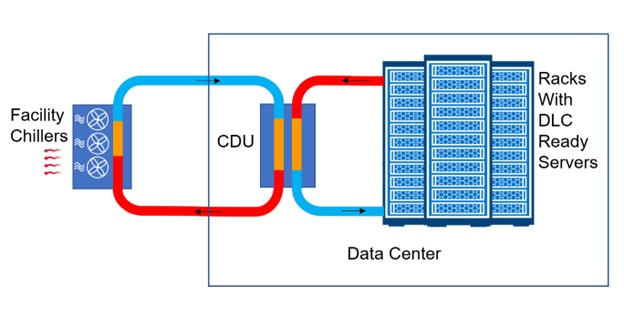Advancements in Liquid Cooling
Many businesses are seeing a transformation in their workflow because to artificial intelligence (AI). By processing and interpreting massive amounts of data in real time, it enhances decision-making and problem-solving abilities and produces predictive analytics that are more accurate in predicting patterns and outcomes. This promotes more innovation in nearly every industry. The increased power consumption brought about by all of this computational and accelerator-based innovation creates cooling issues for data centers.
CPU frequency and core counts have increased over the past decade due to design improvements. In just a few chip generations, CPU Thermal Design Power (TDP) has practically doubled and is expected to climb further. capability-hungry high-performance general-purpose GPUs for AI and ML workloads have evolved to maximize processing capability.
Nevertheless, rack and data center installations are finding it more difficult to deal with the heat consequence. Like CPUs, GPU power consumption has grown significantly in recent years. For instance, the most recent NVIDIA H100 GPUs can draw up to 700W, whereas an NVIDIA A100 GPU in 2021 could only draw 300W. Within the next three years, GPU power consumption could surpass 1000W due to more improvements.
Beyond semiconductor innovation, these potent computers’ cooling concerns are being addressed. With every iteration, cooling components like fans and heat sinks become more efficient. Dell Technologies‘ intelligent system management, or iDRAC, continuously monitors sensors throughout the server and learns from its surroundings to ensure proper cooling with the least amount of fan utilization. With the help of these and other features, Dell’s Smart Cooling technology ensures that even when overall power demands rise, the percentage of server power used for cooling can fall.
Direct Liquid Cooling (DLC), in which a liquid coolant is sent to hot components within each server, is a crucial component of Dell’s Smart Cooling technology. Dell is now using DLC server systems in its third generation. Since DLC is no longer limited to HPC, they now provide 12 DLC-enabled platforms with their 16th generation servers, continuing their journey that began in the HPC market in 2018. DLC-enabled servers are preferred by customers that want to reduce cooling expenses, conserve space, and allocate more of their limited data center power to computation rather than cooling.
Basics of Liquid Cooling Described
The thermal extraction technique known as “liquid cooling” uses liquid coolant to extract heat from any or all of a server’s internal components. Direct Liquid Cooling, or DLC as it is sometimes shortened, is the method used by Dell. In order to gather and transfer heat away from the server, a coolant distribution unit (CDU) moves liquid around a coolant loop, as seen in Dell’s DLC3000 and DLC7000 solutions. The heat is then transferred from the data center to the facility via a heat exchanger. The CPUs and GPUs of PowerEdge servers are in close contact with specially built liquid-cooled cold plates.

The Top Six Advantages of Direct Liquid Cooling
Liquid keeps four times more heat than air because it is significantly more effective at transferring and collecting heat than air cooling. DLC is a desirable alternative for contemporary data centers because it has many benefits over conventional air-cooling techniques.
- Increased density of computation. Higher server densities in data centers are made possible by DLC because it eliminates the need to plan space for the necessary airflow. For instance, users can use PowerEdge C6620, which is air-cooled, to install 58% more CPU cores per rack thanks to Dell DLC.
- Even cooling. Hot spots are removed and a uniform cooling distribution is ensured throughout servers with liquid cooling.
- Enhanced functionality of the server. Liquid cooling allows servers to be kept at supported temperatures, which can enhance performance and even reduce failure rates. The CPU may temporarily apply thermal throttling as a result of overheating, which lowers server performance.
- Energy conservation. With a lower power use effectiveness ratio (PUE), direct liquid cooling can result in energy savings and lower operating costs by eliminating the need for energy-intensive air conditioning systems and high-speed fans.
- Heightened resilience. A lower carbon footprint can result from using less power.
- Lowering of noise. Because direct liquid cooling systems require server fans to run at considerably lower speeds and demand less work from the data center’s air moving infrastructure, they are in general quieter than air cooling systems.

Customers of Dell may now take advantage of a new pre-integrated DLC 3000 or 7000 rack solution for PowerEdge servers, which removes the risk and complexity involved in choosing and installing liquid cooling correctly. If a customer wants to pilot their first DLC solution or wants to install up to five racks, the DLC3000 rack solution is a great option.
It comes with a rack, a rack manifold for distributing coolant to the servers, and an in-rack CDU that can accommodate modular or rack-mounted Dell DLC servers that are ready to be assembled. After being constructed, tested, and delivered to the customer’s data center floor, the rack with integrated DLC3000 cooling solution is connected to the facility’s chilled water supply by the Dell professional services team, who also assures optimal performance. To make the entire process as easy as possible, Dell ProSupport maintenance and warranty coverage supports everything in the rack.



[…] Effective Cooling Architecture: Even when playing intense games, the A750’s dual-fan cooling system with composite heat pipes and big aluminum fin stacks maintains a cool temperature. To add flair, the shroud and back plate feature RGB lighting that can be customized. […]